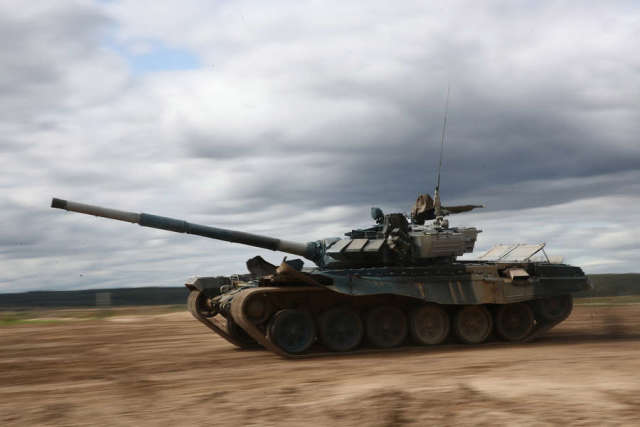The Russian army will test the robot tank "Sturm" for battles in urban conditions
The first prototype of the Russian heavy attack robotic complex "Sturm", created on the basis of the T-72V3, will go to preliminary tests in April. "Newspaper.Ru" figured out what tasks this complex should perform on the battlefield.
According to the Ministry of Defense, the "Assault", designed for urban battles, is armed with a shortened 125-mm cannon. In addition to the remote-controlled tank, the complex includes a mobile command post and a fire support robot - with a pair of 30-mm cannons, rocket-propelled flamethrowers "Bumblebee" and a block of unguided rockets from "Hurricane". All vehicles are based on the T-72B3 tank.
"The meaning of the complex is that a robot that goes ahead of linear tanks becomes the first object of an enemy strike. For him to distinguish a robot from a linear tank is difficult, if not impossible. This means that the survival rate of tank personnel increases dramatically. During urban battles, assault robots will help avoid additional casualties," he told the newspaper.Ru" Corresponding member of the Russian Academy of Rocket and Artillery Sciences, Doctor of Military Sciences Konstantin Sivkov.
He noted that there is a certain range of tasks that involve a great risk for tanks, so it is advisable to assign these tasks to robots.
"These are issues of overcoming minefields, passing rubble. Therefore, a robot based on the T-72V3 is one of the first options that is considered as a robotic machine - it is equipped with a powerful wedge-shaped visor and has a shortened 125-mm standard cannon, which is designed to destroy fortifications and barriers with high-explosive shells," the expert said.
According to Sivkov, the second element of the complex - a fire support robot - should solve the tasks of suppression in the enemy's defense system.
- said Sivkov.
At the same time, the expert noted that modern robots cannot yet act independently, their capabilities for orientation and decision-making are limited. "All the robot can do is see the target, aim and request permission to shoot from the operator. He is not able to develop tactics of actions," Sivkov said.
According to military expert Viktor Litovkin, the principle of controlling unmanned aerial vehicles and ground combat robots is the same. At the same time, both of them are a striking force, their use together with manned equipment makes it possible to solve the issue of dispersal of tasks.
Litovkin also draws attention to the fact that one command post can combine work with several remote-controlled tanks by analogy with unmanned aerial vehicles.
"For example, the flight of the Su-57 was demonstrated in conjunction with the Hunter drone. There can be a dozen of these drones - under the control of a pilot. They fly ahead of the plane, report what they see, transmit targets and the pilot makes a decision to strike, return the drone, conduct reconnaissance. It's the same on earth," Litovkin said.
According to Sivkov, robots are an addition to linear troops, significantly increasing combat capabilities, but at the same time such equipment has "significant drawbacks".
- said Sivkov.
According to him, communication problems inevitably arise in urban development - structures shield the signal passage and the robot's communication with the operator may be disrupted. Especially in the case of small robots, on which it is impossible to put a powerful communication system.
"The network principle will be implemented on robots of the Sturm type - data exchange will be organized simultaneously in the network: commands from the operator can be sent to this or that robot not only directly, but also through other relay robots, which ensures reliable communication," the expert concluded.
Irina Alshayeva

